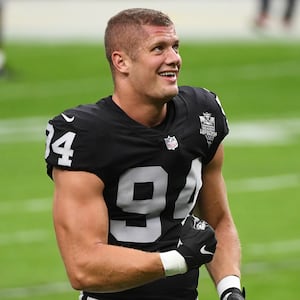The positive response that Las Vegas Raiders’ defensive end Carl Nassib has received after coming out as gay—from the NFL commissioner to teammates, opponents, retired players, and most fans—is heartwarming, encouraging, and most welcome. And as those of us who work in LGBTQ sports have been saying forever, it’s not a surprise.
Every LGBTQ athlete, coach, and support person I’ve encountered in my years in sports journalism and in the time before and since, expressed enormous relief when they came out and were embraced, and not ridiculed or fired or rejected. Every. Single. One.
And just as an aside, it’s sad that in 2021, out women have been playing professionally for decades, while out male athletes are still as rare as a 1-point safety.
ADVERTISEMENT
In its 100-year history, the NFL has had 15 out gay and bisexual players before Nassib, but until now, all but one came out in retirement, as Jim Buzinski reported earlier this year. It goes without saying that if not for Michael Sam blazing a trail seven years ago, Nassib’s journey would be so much harder. For those who don’t follow football, Sam was the first out gay player in the league, but he didn’t make the active roster of either the Rams or the Cowboys following his preseason work with those teams. Nassib stands alone as the only active NFL player to say, “I’m gay.”
What’s changed since 2014? Memories are fleeting, but it’s important to note that Sam was actually widely accepted, and those in the know affirm that his sexual orientation had zero to do with his status on those teams. No doubt there are still stories to be told from behind the scenes, but my sources say what kept Sam from rising to a roster position was unrelated to him being gay.
Sam applauded Nassib on Twitter.
Sam came out just a year before gay hoops icon Jason Collins became the first out active pro athlete in any major U.S. sport—football, baseball, hockey, or basketball—and was also greeted with cheers and warm welcomes.
Why wait, then? Out bisexual NFL free agent R.K. Russell outlined some of the factors in an interview with NFL.com, describing what happened when he was in college and witnessed Sam’s coming out.
“There was a huge amount of talk about ‘media distraction.’ NFL players do not want anything to distract their players from their goal, their day to day, from that week and their opponent,” Russell said, adding that the fear is that by coming out a player might become a hindrance to their club. “That’s beyond me, that being who you are and accepting who you are can be a distraction or a negative thing, but there is that fear.”
Journalist Cyd Zeigler addressed that “distraction” myth in April. “It wasn’t Sam who was distracted by this, it was the NFL media and the Rams who were,” Zeigler wrote. “All along, it was everyone else seemingly more obsessed with every step Sam made. He took it all in stride. So many others blew it all out of proportion.”
Between those days and now, America has changed, and with it, very slowly, so has the NFL. The Supreme Court overturned the Defense of Marriage Act just days before Collins’ announcement. Two years later, the high court issued its landmark decision on marriage equality. Led by the courageous action of Colin Kaepernick beginning in 2016, athletes across pro sports have begun to utilize their platform to support social justice and oppose racism and white supremacy.
While it remains controversial and widely criticized by conservatives, taking a knee is something the NFL will not discourage and a rule against it will not be enforced, according to league commissioner Roger Goodell.
In addition to his stated support for Nassib, Goodell deserves credit for encouraging NFL teams to show support for their LGBTQ fans and employees.
For example, the San Francisco 49ers created the first LGBTQ fan club in the NFL in 2019, and this year they are the first team in the league to offer fans non-gendered apparel. Katie Sowers made history with the team in 2020 by being the first out member of a coaching staff in a Super Bowl, as well as the first woman; she’s now working with the Chiefs.
The NFL also marched in 2019’s World Pride in New York City with out former football player Ryan O’Callaghan on its float.
“I would love to see the NFL use their resources and incredible influence on society to do even more good for the LGBTQ community,” O’Callaghan told me in a 2019 conversation.
What the NFL hasn’t done is send the message to its closeted players, “Come out, come out, wherever you are!” In fact, with the guidance of retired players like former NFL cornerback Wade Davis, it’s told them to do exactly the opposite of what Nassib did Monday.
“I don’t use the language of ‘coming out’ at all,” Davis told me in 2019. “I use the language of ‘inviting in.’ Davis played for the Tennessee Titans, Washington Redskins, and Seattle Seahawks and first revealed his orientation in 2012.
Davis told me he thinks the environment created by the media and especially social media infringes upon that “family” bond a player has with his coaches and teammates. And he said it’s something that is not talked about often enough in these conversations about sexual orientation, both in sports and entertainment.
While so much Twitter noise since Michael Sam came out has focused on straight guys expressing fear that a gay player showering alongside them might find them attractive, the real fear is on the side of the closeted athletes who aren’t “comfortable,” as former quarterback Warwick Moon noted. Comfortable being code for losing a place on the roster, losing sponsorship, fan backlash, and more. All those fears haven’t materialized for Nassib, nor will they for the next guy.
That, to me, will be the real proof of progress: That another player sees a green light now that Nassib has been embraced, and realizes there’s no reason to stay in the closet anymore.
Major League Baseball and the National Hockey League have a long way to go to match the NFL’s and NBA’s levels of acceptance that allowed Nassib and Collins to come out. Allies like Kurtis Gabriel of the San Jose Sharks, who applies Pride Tape to his hockey stick for every game, will make it easier if an NHL player ever comes out.
Billy Bean, MLB’s vice president and special assistant to Commissioner Rob Manfred, is the only out baseball player alive today and he retired in 2013. Bean came out two years later.
He told NFL.com what he sees as a movement by younger, NCAA athletes to reject discrimination, and transfer from their schools “because their coaches had used racist terms and nobody had addressed it, people were complicit,” he said. “That is a huge shift and improvement in culture where athletes should feel empowered enough to say, ‘I don’t want to be subjected to competing, giving everything I’ve got, in an environment that’s discriminating or biased or bigoted.’ And I think that will translate into the LGBTQ+ conversation as well.”







